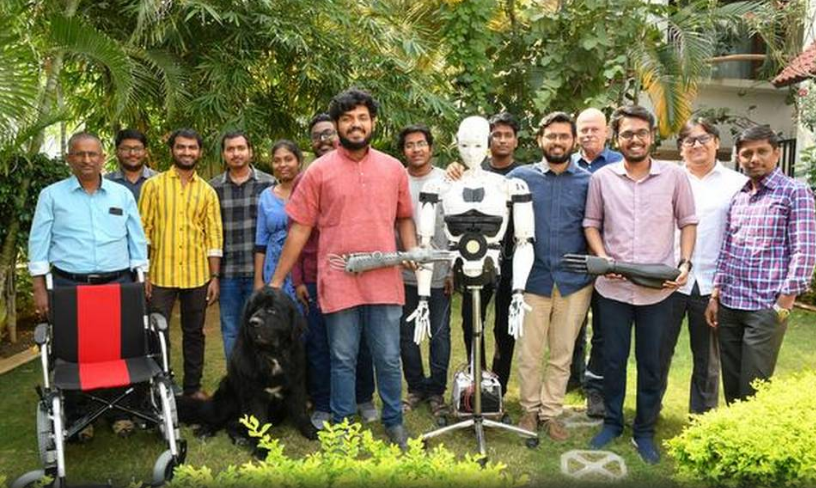
A sculpture made from metal scrap stands at the entrance of Makers Hive office in Jubilee Hills, Hyderabad. The paintings lining the foyer are AI (Artificial Intelligence)-enabled and it’s fun to view them through a dedicated mobile application. These are some of the things the employees have done in their spare time.
When they are seriously at work, they build drones that can be used in the agriculture sector. The idea of looking at tech-led solutions to help the agricultural sector began with the guidance of professor M S Swaminathan, geneticist and significant player in India’s first Green Revolution.
Makers Hive’s other vital area of work is in the area of bionics. The prosthetic, bionic arm developed by them is in its final stages of development and will be up for tests and certification, before it enters the healthcare market. The company intends to make these bionic arms a lot more affordable than it is today. “Sophisticated bionic arms sourced from abroad cost anywhere from ₹25lakh to 35lakh in India; we want to sell our bionic arm at around ₹2.5lakh. We’ve used indigenous raw materials and technology,” says 25-year-old Pranav Kumar, the CEO.
Drones for farming
Pranav’s interactions with M S Swaminathan helped him understand the agriculture sector better. He learnt that much of the damage is done before the naked eye can spot crops being infested by pests in a farm. “Satellite thermal imagery can help in case of large areas, but most farmers in India have only a few acres of land and can benefit from precision imagery taken using drones. If the drone is used to take thermal images once in 15 days, it will help monitor crop health at every stage. We are also working on setting up weather stations, and through drone-generated imagery, can predict the yield per acre. We also want to use drones to monitor solar panels to check for anomalies,” says Pranav. Again, the idea is to have drones in each district that can be used by farmers on a subscription model per year per acre basis.
Pranav worked in the R&D (research and development) wing of Tata Consultancy Services (TCS) Ignite for more than three years, before he became an entrepreneur. “I had access to 24 projects in areas of machine learning, AI, drones, IoT (Internet of Things) and VR (virtual reality). That helped me understand the different domains and I also got to meet M S Swaminathan, who I consider my mentor,” recalls Pranav.
He would meet Swaminathan during weekends and the “urge to use technology to solve real world problems grew. He would talk about four areas where India needs to progress — agriculture, health care, nutrition and education,” remembers Pranav. He decided to focus on the first two areas, gauging the potential for technology-assisted solutions.
Can it match a real arm?
A team of engineers who were passionate about their work and keen to use technology for social change, joined the team.
A survey of prosthetic arms available in India showed that most of them were not capable of a range of grips and movement. “Arm movements are complex. We use our arms and fingers to hold or lift things — like an egg, a visiting card, paper, a bottle of water, type on the keyboard… an artificial limb has to be able to do all this by having different grip patterns,” Pranav explains.
The team spoke to amputees across age groups and social strata to understand their needs. One wanted to be able to work efficiently in the kitchen, a farmer wanted to be able to lift weights and work on the field, a school child wanted to write and paint…
Fourteen to 16 months of work later, the bionic arm was developed using materials and technology available in India. The arm is designed to have 14 grip patterns and can lift up to eight kilograms of weight.

Chanakya Gone, the chief technology officer of the firm, says it was a step-by-step process of understanding medical terminologies, muscle physiology and the needs of the different kinds of amputations. “We looked into electronics, mechanics and aesthetics part of the arm,” he says. The bionic arm weighs around 1.2kilograms.
Once tested and certified, the arms will be available in different sizes to befit age groups. While adults can use the same arm for several years, in growing children and young adults, the arm will need to be changed after three years.
The prosthetic device can be checked periodically using a mobile application that’s being developed, called Dextrous. Check the battery of the device, the nodes, the motors, and identify problem areas. “We want to have district-level customer help centres to solve any issues,” says Pranav.
The team insists this is only a starting point. Plans are on to work further in the area of bionics to develop a brain-controlled wheelchair. Think of a paralytic or a paraplegic person being able to move the wheelchair through brain signals. A glove to stabilise hand movements of a patient afflicted with Parkinson’s disease, exoskeletons that can share the heavy load for soldiers on the border, are all in the works. Efforts are on to get both government and private support for the projects.
Article Credit: thehindu
